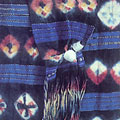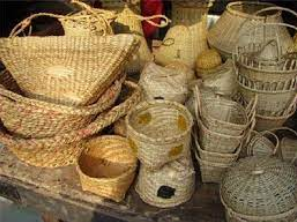The chunari, a wave-patterned Newari textile that was traditionally a must for wedding ceremonies is now a relatively rare sight. Used during the wedding function in Hindu Brahmin and Kshatriya farmer’s homes, the chunari was used as an auspicious wrapping for the dowry gifts taken by the newly-wed bride to her husband’s home. Among the Newars, especially of the sakya caste, the chunari fabric was used to wrap up the nuts, pills of keshari, and other items in a bala or brass bowl that was sent along with the bride to her new home. Chunaries were dyed by the chippah caste; however, these textiles are now almost a thing of the past.
THE NEPALESE CHUNARI & THE INDIAN LEHERIYA
The wave pattern on the textile is achieved by dyeing cloth that has first been tied with nettle yarn to a pre-determined pattern to create a resist design. This technique, the origin of which is lost in antiquity is still a robust tradition in Rajasthan (India). (Interestingly the term chunari in Rajasthan is used for the tying of fabric in roundels or rings, while the term lehariya, literally waves, is used for the wrap resist described as chunari in Nepal.) It is conjectured that the tradition of the tie and dye chunari was introduced into Nepal by the Rajputs. Just as the gift of a chunari marks the auspicious time in a woman’s life in Nepal, so different types of tie-dyed fabrics are worn to mark the seasons, the festivals, and rites of passage in Rajasthan.
TECHNIQUE & PROCESS
The cloth used as a base for tie-dyeing the chunari is fine cotton fabric, usually muslin (malmal, khapi). This is the preferred choice as it allows the dye colour to penetrate the entire tightly rolled up textile material.
The technique used is that of wrap resist. The whole cloth is first soaked in water and then thoroughly washed and dried to remove starch and other impurities and to soften the fabric. The malmal cloth is rolled up and tied at intervals to form stripes. The fabric is rolled from one corner diagonally to the selvedge and is tied at intervals with strings. The string used to tie the chunari traditionally is made from the fibres of stinging nettles. Thus, the reserved portions appear in the form of stripes and not in the form of rings or circles. For every new dyeing, new ties are applied, while some of the old ones are sometimes opened for over-dyeing. Two or three muslin lengths can be dyed together. The dye does not penetrate those parts that are tightly tied and the reserved parts are therefore left un-dyed, thus creating a resist pattern.
PATTERNS
The method of tying and the skill of the chippa determines the pattern of the chunari and the quality of the end product. When the cloth is rolled diagonally from one corner it forms a stripped pattern; when the fold emanates from a corner it forms a stripped pattern; and when the fabric is folded like a fan it produces a zigzag design. After the dyeing is completed and the fabric dried in the sun, the threads when opened show the pattern created: the tied nettle threads resist the dye and create the chunari effect.
These coloured and patterned chunaris are also often created in multiple colours with complex squares and patterns. Re-tying the muslin cloth in an additional or opposite diagonal pattern after the first dye bath, results in patterns in the second colour. The tied portions remain un-dyed; the untied area of the muslin is coloured. At the edges there is a feathery blurring of the colours.
Gallery
YOUR VIEWS
PRACTITIONERS: INDIA
Access 70,000+ practitioners in 2500+ crafts across India.
BIBLIOGRAPHY
10,000+ listings on arts, crafts, design, heritage, culture etc.
GLOSSARY
Rich and often unfamiliar vocabulary of crafts and textiles.
SHOP at India InCH
Needs to be written.






